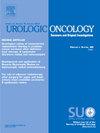Concordance between clinical and pathologic staging of larger (cT2a-b) and more invasive (cT3a) renal cell carcinoma
IF 2.3
3区 医学
Q3 ONCOLOGY
Urologic Oncology-seminars and Original Investigations
Pub Date : 2025-07-01
DOI:10.1016/j.urolonc.2025.06.003
引用次数: 0
Abstract
Introduction and Objectives
Among patients with renal cell carcinoma (RCC), 5%–23% of those with cT1 and smaller cT2 tumors may be upstaged to pT3a disease after surgery. The pathologic restaging rate of larger or clinically more invasive tumors is understudied and has implications for perioperative systemic therapy clinical trial enrollment. We examined rates of pathologic restaging for cT2a-b and cT3a RCC after surgery.
Methods
Using the National Cancer Database, we identified adult patients with cT2a, cT2b, and cT3a RCC undergoing partial or radical nephrectomy. We compared pathologic restaging rates between the clinical stage groups using a Chi-square test. Subgroup analysis of restaging rates was performed for histology (clear cell vs. non–clear cell), clinical nodal status (cN1 vs. cN0), and clinical metastatic status (cM1 vs. cM0). Sensitivity, specificity, positive predictive value, and negative predictive value were calculated for the overall cohort and subgroups. Multivariable logistic regression was performed to assess predictors of pT3a upstaging among patients with cT2a and cT2b tumors.
Results
We identified 31,912 patients who met inclusion criteria (13,840 cT2a, 8,079 cT2b, and 9,993 cT3a). The overall rate of pathologic restaging was 47.4% for cT2a disease, 52.5% for cT2b disease and 9.5% for cT3a disease (P < 0.001; Fig. 1). Most of the restaging was upstaging for cT2a (36.7%) and cT2b (41.9%) disease. The positive predictive value was 52.5%, 47.5%, and 90.6% for cT2a, cT2b, and cT3a disease, respectively. On multivariable analysis, in patients with cT2 tumors, the presence of clinically node-positive (OR 2.8 [95% CI 2.43–3.17]) or metastatic disease (OR 2.4 [95% CI 2.18–2.65]), as well as higher nuclear grade (OR 6.7 [95% CI 5.1–8.9]) was associated with increased risk of pathologic upstaging (P < 0.001).
Conclusions
Restaging is common for patients with cT2a and cT2b tumors, but the specificity of cT3a staging is high, which suggests that the clinical/imaging characteristics concerning for locally invasive disease are generally accurate.
较大(cT2a-b)和侵袭性较强(cT3a)肾细胞癌临床与病理分期的一致性
简介和目的:在肾细胞癌(RCC)患者中,5%-23%的cT1和较小的cT2肿瘤患者在手术后可能会被pT3a疾病所取代。较大或临床侵袭性较强的肿瘤的病理再分期率尚未得到充分研究,这对围手术期全身治疗临床试验的纳入具有重要意义。我们检查了术后cT2a-b和cT3a RCC的病理再分期率。方法:使用国家癌症数据库,我们确定了接受部分或根治性肾切除术的cT2a, cT2b和cT3a RCC的成年患者。我们使用卡方检验比较不同临床分期组的病理再分期率。对组织学(透明细胞vs.非透明细胞)、临床淋巴结状态(cN1 vs. cN0)和临床转移状态(cM1 vs. cM0)的再分期率进行亚组分析。计算整个队列和亚组的敏感性、特异性、阳性预测值和阴性预测值。采用多变量logistic回归评估cT2a和cT2b肿瘤患者pT3a抢先期的预测因素。结果:我们确定了31912例符合纳入标准的患者(13,840例cT2a, 8,079例cT2b和9,993例cT3a)。cT2a疾病、cT2b疾病和cT3a疾病的总体病理再分期率分别为47.4%、52.5%和9.5% (P < 0.001;图1)。大多数的复发是针对cT2a(36.7%)和cT2b(41.9%)疾病。cT2a、cT2b和cT3a疾病的阳性预测值分别为52.5%、47.5%和90.6%。在多变量分析中,在cT2肿瘤患者中,临床淋巴结阳性(OR为2.8 [95% CI 2.43-3.17])或转移性疾病(OR为2.4 [95% CI 2.18-2.65])以及较高的核分级(OR为6.7 [95% CI 5.1-8.9])的存在与病理上分期风险增加相关(P < 0.001)。结论:cT2a和cT2b肿瘤患者普遍存在再分期,但cT3a分期特异性高,提示其局部侵袭性疾病的临床/影像学特征普遍准确。
本文章由计算机程序翻译,如有差异,请以英文原文为准。
求助全文
约1分钟内获得全文
求助全文
来源期刊
CiteScore
4.80
自引率
3.70%
发文量
297
审稿时长
7.6 weeks
期刊介绍:
Urologic Oncology: Seminars and Original Investigations is the official journal of the Society of Urologic Oncology. The journal publishes practical, timely, and relevant clinical and basic science research articles which address any aspect of urologic oncology. Each issue comprises original research, news and topics, survey articles providing short commentaries on other important articles in the urologic oncology literature, and reviews including an in-depth Seminar examining a specific clinical dilemma. The journal periodically publishes supplement issues devoted to areas of current interest to the urologic oncology community. Articles published are of interest to researchers and the clinicians involved in the practice of urologic oncology including urologists, oncologists, and radiologists.

 求助内容:
求助内容: 应助结果提醒方式:
应助结果提醒方式:


